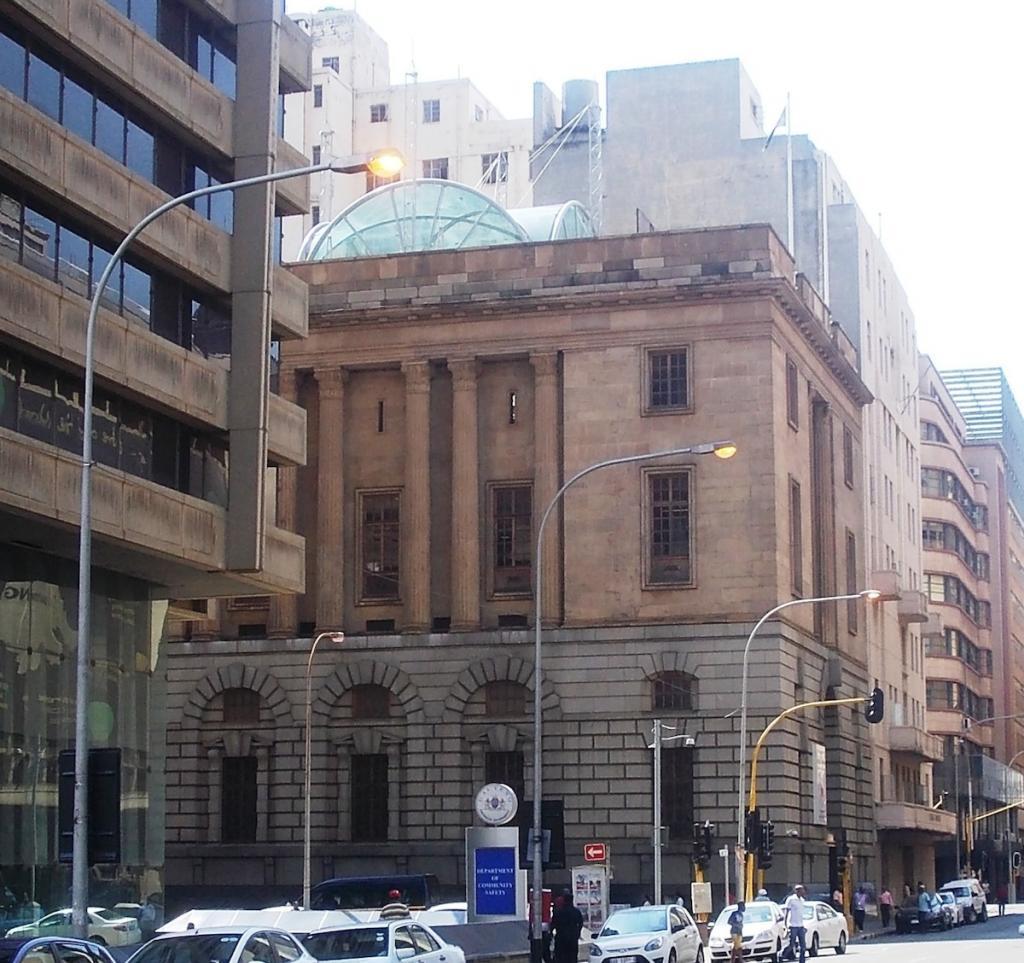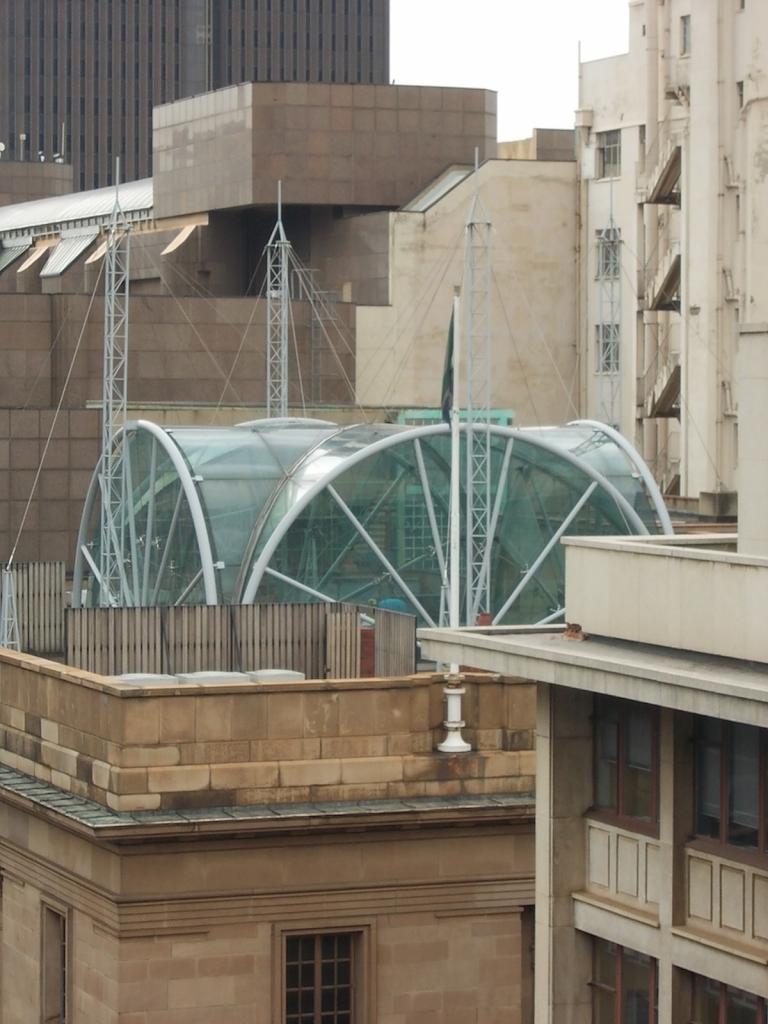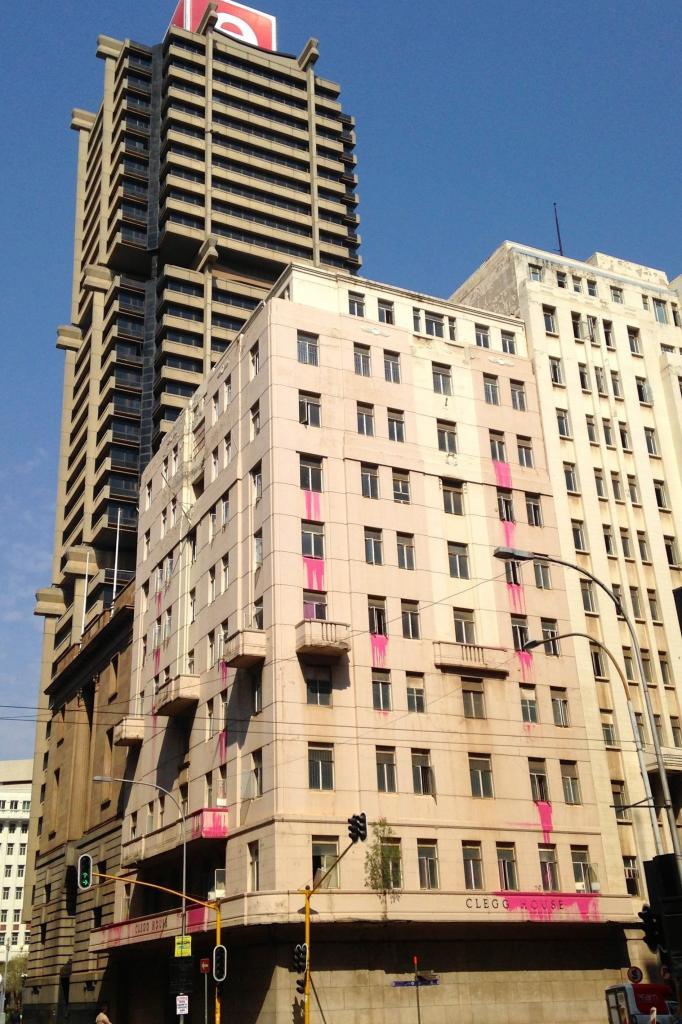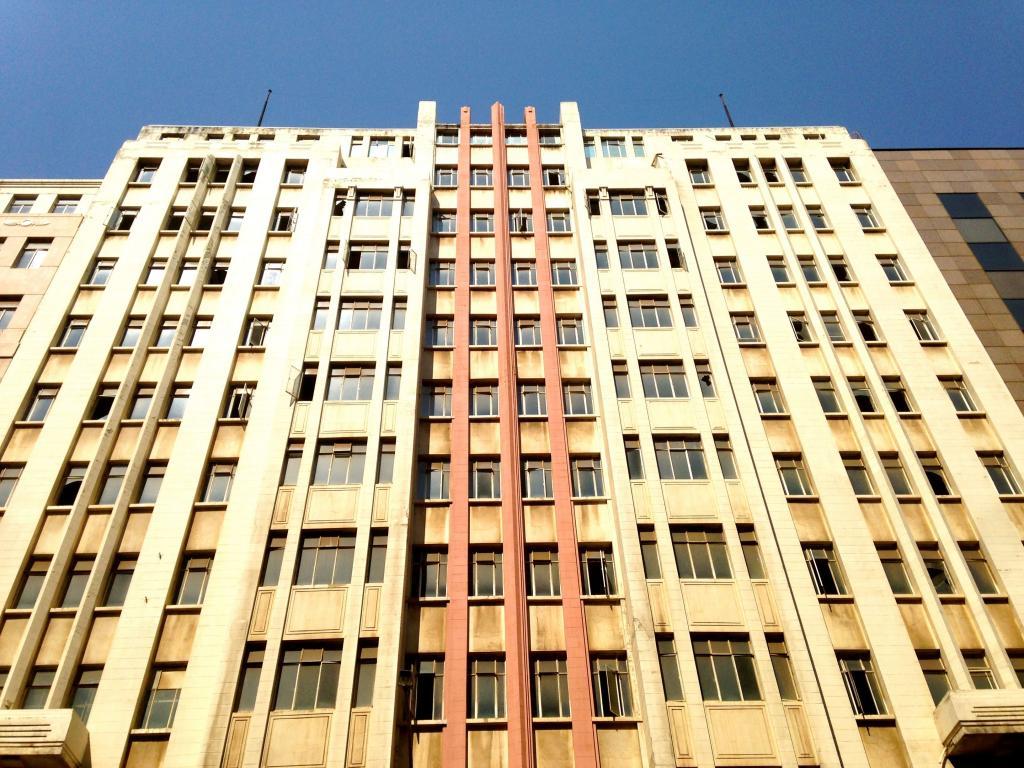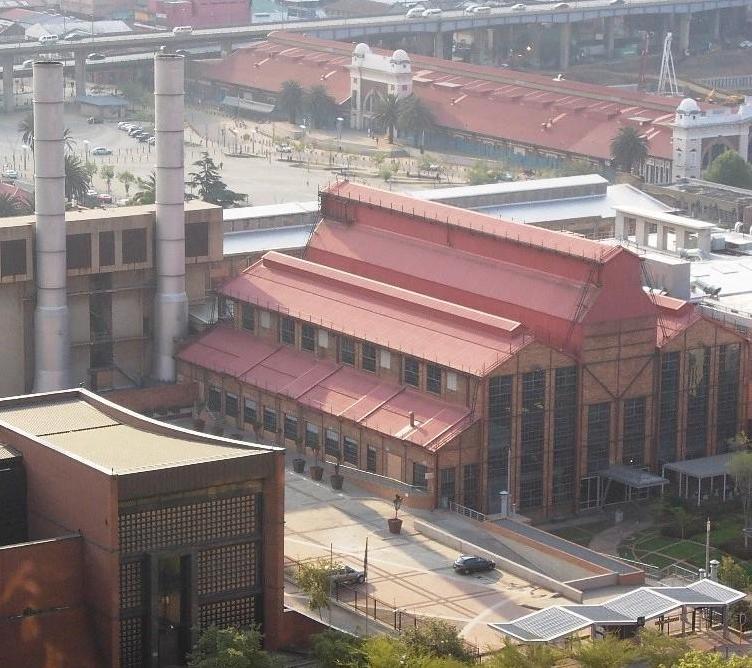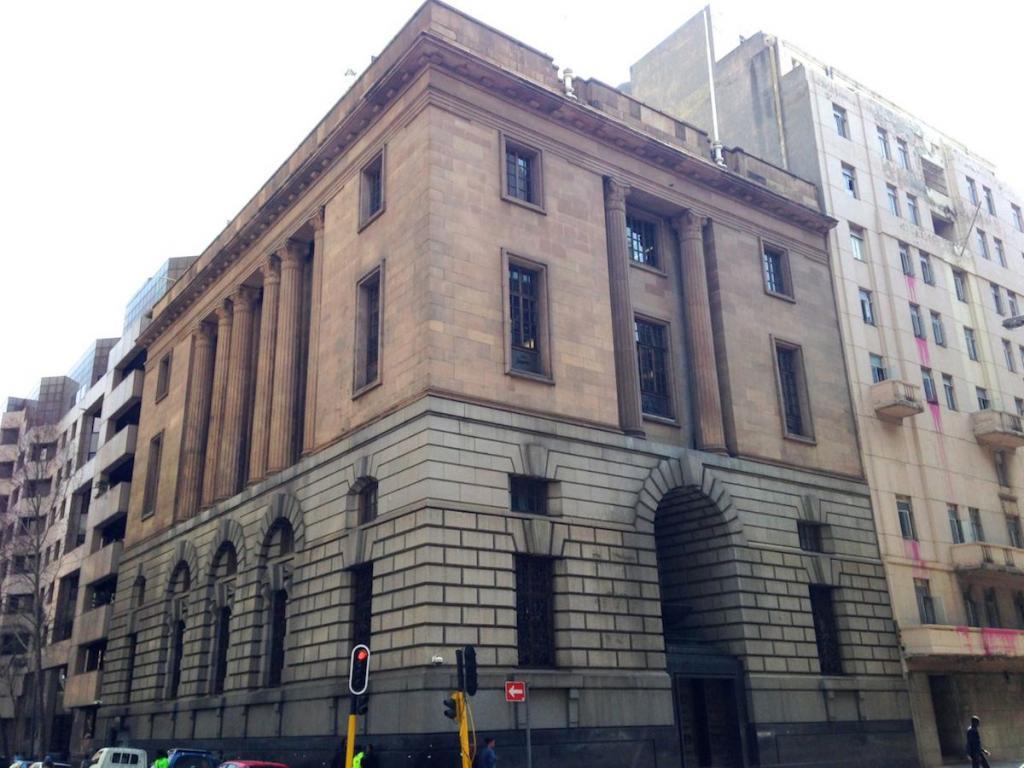
Disclaimer: Any views expressed by individuals and organisations are their own and do not in any way represent the views of The Heritage Portal. If you find any mistakes or historical inaccuracies, please contact the editor.
In the article below, journalist Lucille Davie looks at the restoration of the majestic old Reserve Bank Building in the Johannesburg CBD. The article was first published on the City of Joburg's website on 1 December 2005. Click here to view more of Davie's writing.
The Gauteng legislature got it for R1 in 2002, and now they’re spending R38-million on the building to restore it to its 1930s splendour.
The Old Reserve Bank Building, known now as Matlotlo House, built in 1938 on the corner of Simmonds and Fox streets, is a Gordon Leith design and just beautiful.
Old Reserve Bank from above (The Heritage Portal)
Walking into the building, one is drawn upwards into its beautiful, four-storey volume foyer, with ceiling shaped in the form of a dome, open at the top but originally filled with glass. The dome is supported by marble pillars, behind which are alcoves with vaulted roofs – quite breathtaking. The floor is an expanse of Italian marble.
At three storeys the building stands modestly on the corner, its classical columns and perfectly laid granite slabs offset by a large recessed “bird’s bath” above the impressive moulded, metal front door.
The impressive Gordon Leith design (The Heritage Portal)
The Gauteng province bought the building several years ago, along with about almost two dozen inner city buildings. Two years ago renovations to the building began, says architect Fanuel Motsepe of Motsepe Architects (formerly Ngonyama Okpanum Associates).
The first major task was to knock down a six-metre high steel and concrete “bunker” that had been built in the middle of the entrance foyer.
”It took two months to demolish,” says Motsepe, grimacing at the thought of the 8mm steel plates and granite infill that he and his team faced in their efforts to restore the foyer.
The bunker was added sometime in the 1980s, an effort to make the already-secure building more secure. Motsepe says the bunker was divided into five or six passageways, leading to counters.
The floor had been long stripped of its original marble tiles by then, replaced with industrial interlocking grey tiling.
The building and its finishes are largely still intact: the brass banister at the entrance, the parquet flooring in most rooms, the wood panelling and granite fireplaces, the beautiful light fittings (duplicates have had to be made too), the brass window frames, and the double-glass leaded doors.
Motsepe expresses some regret at having to put modern tiles into the toilets. “We just couldn’t find the lime green tiles locally,” he says. The toilets have replacement yellow and grey tiles, with modern stand-alone basins, perhaps the only concession to something contemporary.
In places damaged wood panelling has been replaced, with duplicates made to match as close as possible. Damaged floor tiling has been removed and replaced with strips of grey concrete, blending perfectly with surrounding tiles or parquet.
The space above the domed entrance is open, with four sides of offices, making up four floors. Most of the brass-framed windows lining the open atrium of the dome have been removed, with only the windows on the corners remaining in memory of the original layer of architecture.
The first floor windows have what must be the most delightful burglar bars in the city: wrought iron grilles, shaped into animals like giraffes, elephants, hippopotami and antelope.
The vault in the basement of the building is a thing to behold. Its 700cm wide steel door is impressive – no one would have got through that to the gold bars behind it. The rest of the basement is a labyrinth of thick walls and interleading rooms.
The roof of the building is a perfect extension of the entrance foyer. Motsepe has taken the vaulted ceilings up on to the roof, where a rounded steel frame has been placed, called a groin vault, to be covered with glass. He says he wants to create an outdoor entertainment area on the roof for the staff, an area previously never used for functions.
Roof of the Reserve Bank Building (The Heritage Portal)
The building was finally mothballed in the early 1990s, when, after operations had spread into the adjoining Clegg House and SA Reserve Bank building in Commissioner Street, it was felt that the work flow was being hampered, in addition to problems with vehicle flow in the three buildings.
The renovation is expected to be complete early in 2006, when the provincial treasury department or the development planning department will take up the space.
Clegg House (The Heritage Portal)
SARB House
The city has several other Reserve Bank buildings. Around the corner in Commissioner Street, is the South African Reserve Bank building, known at SARB house, at present vacant but recently also bought by the Gauteng province.
The building was built in Art Deco style in 1935 by JC Cook & Cowen. Its straight vertical lines draw one upwards to its rounded edges at the top of the building. Although it has little of the beauty of its fellow Art Deco buildings in Commissioner Street, with their attractive roundness and friezes, it offers a subtle counterpoint to them with its three thin pink stripes running up its middle.
SARB House (The Heritage Portal)
The building was designed for street-level shops and offices, but the shops were later converted to office space.
According to the city’s 2004 Heritage Survey, the building was originally known as Transvaal House. From 1958 it changed names to Eagle House (Eagle Insurance occupied it); by 1961 it became known as JIC House, and by 1976 it again changed names to the South African Reserve Bank House or SARB House, when Reserve Bank operations spilled into the building.
Various tenants included stationers, an arms and ammunitions dealer, a literary and educational services company, Anglo American Utility Services, several loss and accident assessors, several legal firms, and a diamond mining company.
New SA Reserve Bank building
Built in 1996, the new SA Reserve Bank Building in West Street, Newtown, makes its presence felt on the western border of the CBD – surely no one can ignore its solid red brick edifice, broken by interesting angles and shapes. Despite being modern and large and angular, it blends with the rusty lines of the large, glass-walled Turbine Hall alongside it, and heralds the start of Newtown with its dramatic profile.
Built by Floris Smith & Meyer Pienaar Architects and Urban Designers (now Meyer Pienaar Tayob Architects), it proved to be a great challenge for the architects, leading to “an innovative design solution”, according to the January-February 1993 Architecture SA magazine.
The building had to project an image of being very secure but at the same time be a people-friendly building, blending in with the “varied fabric” of its surrounds – in particular two old buildings: the coal-fired power station of 1927, known as the Turbine Hall, and its predecessor, the 1906 Electric Workshop, now the Sci-Bono Discovery Centre.
“We had to treat it like a fortress, with a keep inside,” says architect Chris Malan now, project leader at the time.
Consisting of five levels, the two lower levels contain functions to do with the main operations of the bank, plus air-conditioning plant rooms, maintenance areas and parking. These levels protrude above ground level, creating a podium, and on to this podium “the remaining spaces of the building are placed in the form of a number of smaller structures, each housing a distinct function of the building”. The podium is surrounded by brick walls.
The exterior brickwork comes inside in the form of an avenue of beautifully crafted, tall arches, with a large arched window facing the ghostly shapes of the Turbine Hall, in the process of re-development as the new headquarters of Anglogold Ashanti. The interior is filled with large windows, and overlooks pebbled gardens and pools, allowing light to pour in. The neighbouring tall glass diamond building provides a dreamy view for workers.
Turbine Hall from above with part of the Newtown Reserve Bank Building on the left (The Heritage Portal)
Natural light flows through from the roof down a central two-storey atrium, linked to the rest of the building by steel bridges.
Malan says the brickwork was an “adventurous undertaking”. An “engineered brick” was created, based on a flatter European brick but made locally. Special training programmes were established on site.
The banking hall is separated from the office area by a glass brick wall, with a skylight providing diffused light from the roof garden.
The fifth level of the building consists of a staff lounge and dining rooms, and a recreation area and gym, finished in practical red rubber cladding.
The interior walls are finished in face brick and dark green granite, set in places in horizontal bands in the brick. This finish is complemented by other surfaces: white marble, blond maple panelling, steelwork and stainless steel trims.
Overlooked by taller buildings to the east, the roof has been designed as a “fifth façade” of the building, finished in copper and softened with a roof garden.
The architects designed special fittings for the building – the air-conditioning units which stand “as solid soldiers at the end of light-filtered passages and the sculpted two-metre tall skylights that double as sculptures in the roof gardens” (Architectural and Planning Review for southern Africa, 143), to the light fittings.
So, although the essence of the building is high security, by means of roof gardens, plants, warm textures and skylights, staff have not been made to feel like prisoners in the fortress-like building.
”The understanding of the dramatic consequences of the subtle use of light in the high vaulted structure in the main circulation spine has softened the severity of the lines and accentuated the inherent qualities of the materials selected,” according to the review.
Lucille Davie has for many years written about South Africa's people and places, as well as the country's history and heritage. Take a look at lucilledavie.co.za
Comments will load below. If for any reason none appear click here for some troubleshooting tips. If you would like to post a comment and need instructions click here.


